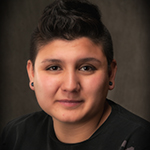
Gabriela Herní¡ndez
Las Vegas, N.M. — New Mexico Highlands University media arts and Spanish graduating senior Gabriela Herní¡ndez presents a workshop titled Jotería: Undocumented April 15 at 5:30 p.m. in the Student Union Building, Room 321.
The student union is at the northwest corner of National Avenue and 8th Street.
Herdí¡ndez, 21, came undocumented from Ciudad Juarez, Mexico to Colorado at age 7, along with her mother and two older sisters. She is the first in her family to attend college, arriving at Highlands as a freshman.
Herní¡ndez is a lesbian and said jotería comes from the Spanish words jota and joto, which mean lesbian and gay respectively. She uses jotería to refer to the gay community. LGBQT means lesbian, gay, bisexual, queer and transgender.
“The vision for the Jotería: Undocumented workshop is to educate our audience about the existing intersection among the LGBQT and undocumented communities, as well as clear up the terminology used to target both communities,” Herní¡ndez said. “It’s an informal, engaging workshop where people get to talk first about the struggles of the LGBQT community. The second part is a group discussion about immigration and what undocumented means.”
Herní¡ndez said there are many misperceptions about LGBQT and undocumented people that will be explored in the workshop. She’ll also tell her personal story.
Herní¡ndez said four years ago she discovered one of her biggest passions: organizing for human rights. For two years at Highlands she was president of MEChA, the Movimiento Estudiantil Chicana/0 de Aztlí¡n. She also co-founded New Mexico Dreamers in Action.
“I fell in love with helping people, especially my immigrant community. I see and live the injustice every day, and made a decision to fight for my rights, my family’s, and the community. My main goal with the workshop is to motivate people to take action in our movement. At the end of the day, that’s what every activist wants,” Herní¡ndez said.
She gave examples of taking action: signing online petitions in support of stopping deportations that separate families, getting involved in organizations that support LGBQT and immigration issues, and using different language — like dropping “illegal alien” because it’s dehumanizing and instead using “undocumented.”
Herní¡ndez has presented the Jotería: Undocumented workshop in Albuquerque, Santa Fe, Las Cruces, Española, Las Vegas, and other cities. On April 11, she presents at the National Association for Chicana and Chicano Studies annual conference in Salt Lake City.
She was awarded a media arts Seabury Fellowship to develop her project to create a series of banners representing LGBQT undocumented people.
The striking 3′ by 9′ banners incorporate traditional Mexican culture and religion, using a vibrant color palette of burgundy, teal, hunter’s green, chocolate brown, and others. Herní¡ndez digitally hand drew the images of the real people featured in the banners using Adobe Illustrator software.
“Another goal for the workshop is for people to start realizing the importance of art in the LGBQT and immigration movements. That’s why I designed the banners. I want to encourage more artistic expression on these two issues,” Herní¡ndez said.
Media arts professor Megan Jacobs coordinates the Seabury fellowships and is Herní¡ndez’ adviser.
“Gabriela is a very intelligent, versatile designer who is sophisticated in her research, using the knowledge behind her work to propel her designs to a new level,” Jacobs said. “It’s remarkable that at 21, Gabriela has the insight to create images that are both visually evocative and conceptually provocative. Her designs resonate with viewers and her workshop participates alike.”
Herní¡ndez said the media arts program has prepared her to pursue her lifework. She completed the U.S. deferred action for childhood arrivals process, granting her a two-year work permit.
“Professionally, I want to combine my art with activism. I have found what I love and media arts taught me the design skills, and how to use the technology tools. I’ve also learned how to be a critical thinker,” Herní¡ndez said.
She said she’s thankful for her media arts professors.
“The media arts program is very engaging and the professors are amazing, always willing to help and give feedback. They’re also very accepting of new ideas,” Herní¡ndez said.
